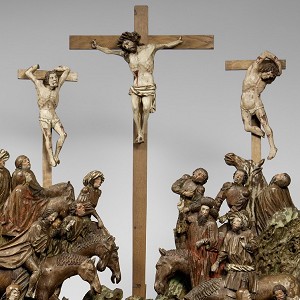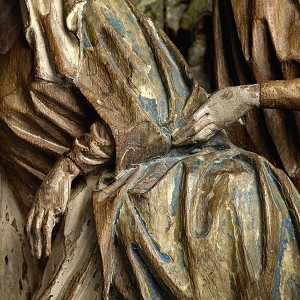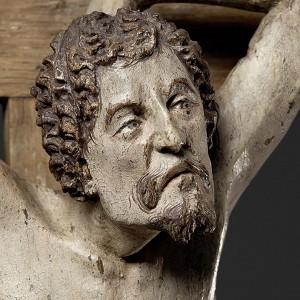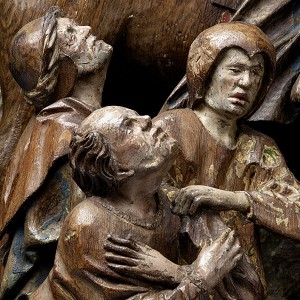
The Great Calvary.
Presenting a New Acquisition
Since 27 November 2013
The group of four women sorrowfully lamenting Jesus’ death on the cross is of touching beauty. The group is part of a rendering of the crucifixion of Jesus that is vibrantly alive with figures. What makes the artwork special is that, emotionally, the sorrow of the Virgin Mary and her companions has become just as significant as the crucifixion itself. The museum was able to acquire the carved group in 2012 thanks to the support of the Kulturstiftung der Länder (Cultural Foundation of the Federal States), the Peter and Irene Ludwig Foundation, the Sparkassen Kulturstiftung Rheinland (Cultural Foundation of the Sparkasse Bank in the Rhineland) and Pro Arte Medii Aevi – Friends of Museum Schnütgen e.V. The acquisition is a significant addition to the rendering of the Great Calvary that was already in the possession of Museum Schnütgen.
A large crowd has come to see the crucifixion of Jesus and the two criminals. The people are witnesses to the historical event as it is described in the Gospels and later accounts of the Passion of Jesus. The second focal point of the composition is to be found immediately below Christ: the fainting figure of the Mother of God is flanked on either side by her two sisters Mary Salome and Mary of Cleophas. A further woman, in profile, is bending towards the Virgin Mary from the side. This is either Mary Magdalene or St. Veronica, who originally held the cloth which was imprinted with a likeness of the living Jesus on the Way of the Cross. St. John the Apostle quite probably stood behind the Mother of God, in order to support her, so that the three figures standing around the Virgin Mary formed a central group under the cross.
While the crucifixion scene with the riders and soldiers has been in the possession of the Museum Schnütgen since 1965, the acquisition of the mourning women in 2012 has shed new light on the meaning of the composition. Originally, this relief was the central piece of an altar shrine. It is one of the highest quality examples of Burgundian Netherlandish sculpture from the first half of the 15th century. The piece is especially valuable due to its partially preserved, original polychrome. Dendochronological testing of the oak has confirmed its dating and revealed that the wood was imported from the Baltic Sea region.
TV segments on the Great Calvary:
WDR Fernsehen, West ART Meisterwerke
WDR West ART Meisterwerke
Deutschlandfunk, Kultur Heute
DLF Kultur Heute







